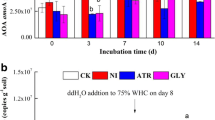Abstract
The effect of 2-hydroxybenzoate (2-OHB, salicylate) on the mineralization rate of [14C]naphthalene, the population density of naphthalene-degrading bacteria, and the concentration of genes encoding for naphthalene dioxygenase in a soil bacterial community was investigated. Six different concentrations of 2-OHB (10, 20, 50, 100, 150 and 200 μg g−1 soil) were tested in 100-g portions of soil. The addition of 10, 20 or 50 μg 2-OHB g−1 soil produced a general increase in total soil bacterial population density, whereas the addition of 100 μg or 200 μg 2-OHB g−1 soil specifically increased the proportion of naphthalene degraders relative to the total population. The addition of 50 μg 2-OHB g−1 soil produced a fourfold increase (the maximum observed) in the rate of naphthalene mineralization relative to the rate in unamended soil. The concentration of 2-OHB (≤ 100 μg/g) added to soil correlated with the population density of naphthalene degraders (r=0.961). Addition of up to 200 μg 2-OHB g−1 correlated with the abundance of DNA sequences homologous to known naphthalene dioxygenase genes (nahAB) (r=0.958). However, mineralization of [14C]naphthalene was stimulated significantly only by the addition of 50 μg 2-OHB g−1 soil. Results of the mineralization experiments were supported by the detection of nahAB mRNA extracted directly from soil. The specificity of the effect of 2-OHB on naphthalene biodegradation was confirmed in a control experiment using equivalent concentrations of 4-OHB which repressed naphthalene mineralization by about 50%. Addition of ammonium nitrate to the soil also increased the rate of naphthalene mineralization. Ammonium nitrate added together with 2-OHB reduced the mineralization enhancement effect of either compound alone. The study confirmed that specific induction of biodegradative genes can enhance chemical pollutant removal in situ.
Similar content being viewed by others
References
All-Bashir B, Cseh T, Samson R (1990) Effect of soil/contaminant interactions on the biodegradation of naphthalene in flooded soil under denitrifying conditions. Appl Microbiol Biotechnol 34:414–419
Belasco G, Higgins CF (1988) Mechanisms of mRNA decay in bacteria: a perspective. Gene 72:15–23
Burlage RS, Sayler GS, Larimer F (1990) Monitoring of naphthalene catabolism by bioluminescence with nah-lux transcriptional fusions. J Bacteriol 172:4749–4757
Ensley BD, Gibson DT, LaBorde AL (1982) Oxidation of naphthalene by a multicomponent enzyme system from Pseudomonas sp. strain NCIB 9816. J Bacteriol 149:948–954
Heitkamp MA, Freeman JP, Cerniglia CE (1987) Naphthalene biodegradation in environmental microcosms: estimates of degradation rates and characterization of metabolites. Appl Environ Microbiol 53:129–136
King JMH, Digrazia PM, Applegate B, Burlage R, Sanseverino J, Dunbar P, Larimer F, Sayler GS (1990) Rapid and sensitive bioluminescent reporter technology for naphthalene exposure and biodegradation. Science 249:778–781
Laflamme RE, Hites RA (1978) The global distribution of polycyclic aromatic hydrocarbons in recent sediments. Geochem Cosmochim Acta 42:289–303
Milhecic JR, Luthy RG (1988) Microbial degradation of acenaphthene and naphthalene under denitrification conditions in soilwater systems. Appl Environ Microbiol 54:1188–1198
Ogunseitan OA, Delgado I, Tsai Y-L, Olson BH (1991) Effect of 2-hydroxybenzoate on the maintenance of naphthalene-degrading bacteria in seeded and unseeded soil. Appl Environ Microbiol 57:2873–2879
Rochkind ML, Blackburn JW, Sayler GS (1986) Microbial decomposition of chlorinated aromatic compounds. EPA/600/2–86/090. Hazardous Waste Engineering Laboratory, U. S. Environmental Protection Agency, Cincinnati, Ohio
Sambrook J, Fritsch EF, Maniatis T (1989) Molecular cloning: a laboratory manual, 2nd edn. Cold Spring Harbor Laboratory, Cold Spring Harbor, N.Y.
Schell MA (1985) Transcriptional control of the nah and sal hydrocarbon-degrading operons by the nahR gene product. Gene 36:301–309
Schell MA, Sukordhaman M (1989) Evidence that the transcription activator encoded by the Pseudomonas putida nahR gene is evolutionarily related to the transcription activators encoded by the Rhizobium nodD genes. J Bacteriol 171:1952–1959
Tsai Y-L, Olson BH (1991) Rapid method for direct extraction of DNA from soil and sediments. Appl Environ Microbiol 57:1070–1074
Tsai Y-L, Park MJ, Olson BH (1991) Rapid method for direct extraction of mRNA from seeded soils. Appl Environ Microbiol 57:765–768
Yland MW (1986) Contamination from a coal tar processing industry: investigation and remedial actions. In: Assink JW, Brink WJ (eds) Contaminated soil. Martinus Nijohoff, Dordrecht, pp 831–848
Author information
Authors and Affiliations
Additional information
Correspondence to: O. A. Ogunseitan
Rights and permissions
About this article
Cite this article
Ogunseitan, O.A., Olson, B.H. Effect of 2-hydroxybenzoate on the rate of naphthalene mineralization in soil. Appl Microbiol Biotechnol 38, 799–807 (1993). https://doi.org/10.1007/BF00167148
Received:
Accepted:
Issue Date:
DOI: https://doi.org/10.1007/BF00167148




